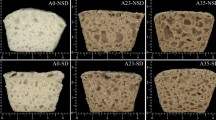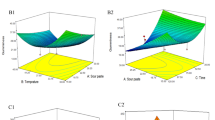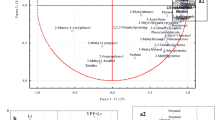Abstract
The objective of this research was to study spontaneously fermented chestnut flour sourdough and to evaluate its effect in gluten-free bread based on corn starch and chestnut flour. Lactic acid bacteria and yeasts counts, pH and titratable acidity of chestnut flour sourdough were measured during 6 days of sourdough propagation. Chestnut flour sourdough fermented for 5 days with back-slopping every 24 h with 33 % of the ripe sourdough was selected to elaborate gluten-free bread. Control breads contained 15, 20 or 25 % of chestnut flour, and sourdough breads contained the same amount of chestnut flour added as chestnut flour sourdough. Chestnut flour sourdough improved bread specific volume, rendered breads with lighter crusts, reduced crumb hardness at day 0 and day 7 and reduced pH. However, chestnut flour sourdough had no effect on yeasts and molds growth during 7 days of bread storage and did not influence sensory characteristics perceived by consumers.



Similar content being viewed by others
References
Rosell CM, Barro F, Sousa C, Mena MC (2014) Cereals for developing gluten-free products and analytical tools for gluten detection. J Cereal Sci 59:354–364
Aguilar N, Albanell E, Miñarro B, Capellas M (2015) Chickpea and tiger nut flours as alternatives to emulsifier and shortening in gluten-free bread. LWT Food Sci Technol 62:225–232
Hager AS, Arendt EK (2013) Influence of hydroxypropylmethylcellulose (HPMC), xanthan gum and their combination on loaf specific volume, crumb hardness and crumb grain characteristics of gluten-free breads based on rice, maize, teff and buckwheat. Food Hydrocoll 32:195–203
Martínez MM, Marcos P, Gómez M (2013) Texture development in gluten-free breads: effect of different enzymes and extruded flour. J Texture Stud 44:480–489
Aponte M, Boscaino F, Sorrentino A, Coppola R, Masi P, Romano A (2013) Volatile compounds and bacterial community dynamics of chestnut-flour-based sourdoughs. Food Chem 141:2394–2404
Moroni MM, Dal Bello F, Arend EK (2009) Sourdough in gluten-free bread-making: an ancient technology to solve a novel issue? Food Microbiol 26:676–684
Gobbetti M, De Angleis M, Di Cagno R, Rizzelo CG (2008) Sourdough/lactic acid bacteria. In: Arendt EK, Dal Bello F (eds) Gluten-free cereal products and beverages. Academic Press, San Diego
Katina K, Heiniö RL, Autio K, Poutanen K (2006) Optimization of sourdough process for improved sensory profile and texture of wheat. LWT Food Sci Technol 39:1189–1202
Katina K, Arendt EK, Liukkonen KH, Autio K, Flander L, Poutanen K (2005) Potential of sourdough for healthier cereal products. Trends Food Sci Technol 16:104–112
Rizzello CG, De Angelis MD, Di Cagno F, Camarca A, Silano M, Losito I, De Vincezi MD, De Bari MD, Palmisano F, Maurano F, Gianfrani C, Gobbetti M (2007) Highly efficient gluten degradation by lactobacilli and fungal proteases during food processing: new perspectives for celiac disease. Appl Environ Microbiol 13:4499–4507
Chenlo F, Moreira R, Pereira G, Silva CC (2007) Evaluation of the rheological behaviour of chestnut (Castanea stavia Mill) flour pastes as function of water content and temperature. Electron J Environ Agric Food Chem 6:1794–1802
Sacchetti G, Pinnavaia GG, Guidolin E, Dalla-Rosa M (2004) Effects of extrusion temperature and feed composition on the functional, physical and sensory properties of chestnut and rice flour-based snack-like products. Food Res Int 37:527–534
Demirkesen I, Mert B, Sumnu G, Sahin S (2010) Utilization of chestnut flour in gluten-free bread formulations. J Food Eng 101:329–336
Moreira R, Chenlo F, Torres MD (2013) Rheology of gluten-free doughs from blends of chestnut and rice flours. Food Bioproc Tech 6:1476–1485
AOAC (2005) Official methods of analysis of AOAC international. Association of Official Analytical Chemists, Gaithersburg
Coda R, Di Cagno R, Rizzello CG, Nionelli L, Edema MO, Gobbetti M (2011) Utilization of African grains for sourdough bread making. J Food Sci 76:M329–M335
Aguilar N, Albanell E, Miñarro B, Guamis B, Capellas M (2015) Effect of tiger nut-derived products in gluten-free batter and bread. Food Sci Technol Int 21:323–331
Moroni MM, Arendt EK, Morrissey JP, Dal Bello F (2010) Development of buckwheat and teff sourdoughs with the use of commercial starters. Int J Food Microbiol 142:142–148
Coda R, Rizzello CG, Gobbetti M (2010) Use of sourdough fermentation and pseudo-cereals and leguminous flours for the making of a functional bread enriched of γ-aminobutyric acid (GABA). Int J Food Microbiol 137:236–245
Novotni D, Cukelj N, Smerdel B, Bituh M, Dujmic F, Curic D (2012) Glycemic index and firming kinetics of partially baked frozen gluten-free bread with sourdough. J Cereal Sci 55:120–125
Schober TJ, Bean SR, Boyle DL (2007) Gluten-free bread improved by sourdough fermentation: biochemical, rheological, and microstructural background. J Agric Food Chem 55:5137–5146
Sabanis D, Lebesi D, Tzia C (2009) Effect of dietary fibre enrichment on selected properties of gluten-free bread. LWT Food Sci Technol 42:1380–1389
Wolter A, Hager AS, Zannini E, Czerny M, Arendt EK (2014) Influence of dextran-producing Weisella cibaria on baking properties and sensory profile of gluten-free and wheat breads. Int J Food Microbiol 172:83–91
Galle S, Schwab C, Dal Bello F, Coffey A, Gänzle M, Arendt EK (2012) Influence of in situ synthesized exopolysaccharides on the quality of gluten-free sorghum sourdough bread. Int J Food Microbiol 155:105–112
Moroni AV, Dal Bello F, Zannini E, Arendt EK (2011) Impact of sourdough on buckwheat flour, batter and bread: biochemical, rheological and textural insights. J Cereal Sci 54:195–202
Moore MM, Schober TJ, Juga B, Arendt EK (2007) Effect of lactic acid bacteria on the properties of gluten-free sourdoughs, batters and the quality and ultrastructure of gluten-free bread. Cereal Chem 84:357–364
Moore MM, Dal Bello F, Arendt EK (2008) Sourdough fermented by Lactobacillus plantarum FST 1.7 improves the quality and shelf life of gluten-free bread. Eur Food Res Technol 226:1309–1316
Schwab C, Mastrangelo M, Corsetti A, Ganzle M (2008) Formation of oligosaccharides and polysaccharides by Lactobacillus reuteri LTH5448 and Weisella cibaria 10M in sorghum sourdoughs. Cereal Chem 85:679–684
Ribeiro B, Rangel J, Valentão P, Andrade PB, Pereira JA, Bölke H, Seabra RM (2007) Organic acids in two Portuguese chestnut (Castanea sativa Miller) varieties. Food Chem 100:504–508
Cizeikiene D, Joudeikiene G, Paskevicius A, Bartkiene E (2013) Antimicrobial activity of lactic acid bacteria against pathogenic and spoilage microorganism isolated from food and their control in wheat bread. Food Control 31:539–545
Rizzello CG, Cassone A, Coda R, Gobbetti M (2011) Antifungal activity of sourdough fermented wheat germ used as an ingredient for bread making. Food Chem 127:952–959
Acknowledgments
N. Aguilar acknowledges the “Ministerio de Educación y Ciencia” for her grant (AP2009-0859). We thank Mesa del Castaño del Bierzo for kindly supplying chestnut flour. We also thank Núria Garreta for her laboratory work.
Author information
Authors and Affiliations
Corresponding author
Ethics declarations
Conflict of interest
The authors declare that they have no conflict of interest.
Compliance with ethics requirements
We thank the consumers -all of them volunteers- that participated in the preference study.
Rights and permissions
About this article
Cite this article
Aguilar, N., Albanell, E., Miñarro, B. et al. Chestnut flour sourdough for gluten-free bread making. Eur Food Res Technol 242, 1795–1802 (2016). https://doi.org/10.1007/s00217-016-2679-z
Received:
Revised:
Accepted:
Published:
Issue Date:
DOI: https://doi.org/10.1007/s00217-016-2679-z




